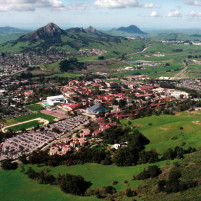Cal Poly San Luis Obispo reaches diversity milestone
October 29, 2024
 By KAREN VELIE
By KAREN VELIE
For the fist time, Cal Poly in San Luis Obispo achieved an important diversity milestone in its effort to achieve Hispanic serving institution designation. In its fall enrollment, the university’s Hispanic student enrollment hit the required 25%.
If the university maintains the 25% threshold for two consecutive years, it will achieve Hispanic serving institution status which unlocks access to resources and grants. Hispanic students make up approximately 29% of the incoming undergraduate class.
Hispanic enrollment has seen an 87% growth over the last decade, compared to 13% overall enrollment growth since 2014. Hispanic students accounted for roughly 15% of the student population in 2014.
“We are excited and proud to have achieved this important milestone on our journey toward designation as an Hispanic serving institution — which in itself is an important marker toward opening our doors more widely to underrepresented, first-generation, lower-income, and other students who in years past may not have had the option of attending Cal Poly,” said President Jeffrey D. Armstrong. “This progress speaks to the hard work and dedication of many of our staff, faculty and administrators. However, this effort is far from finished. We need to grow, and we need to continue to attract and enroll a more diverse student body.”
This is the second year in Cal Poly’s history that no single ethnic student group makes up more than 50% of the total enrollment. In addition, underrepresented minority students make up 30% of the university’s incoming undergraduate class this fall, compared to 18% 10 years ago. For transfer students, the number is 44% this fall, compared to 30% in 2014.
Cal Poly also has seen growth in enrollment of transfer students and local students — important metrics in the university’s role as a steward of place. This year, the university has seen a 12.5% increase in the incoming transfer student class. As well, local students are two times more likely to gain admission than non-local students (60% admission rate versus 30%), and the university’s incoming class will include more than 800 students from the local area — an increase of more than 25% versus last year.






The comments below represent the opinion of the writer and do not represent the views or policies of CalCoastNews.com. Please address the Policies, events and arguments, not the person. Constructive debate is good; mockery, taunting, and name calling is not. Comment Guidelines